Applied Corporate Strategy Assessment
VerifiedAdded on 2023/01/10
|13
|4186
|71
AI Summary
Note:- You need to choose just one company from the attached document given: ''Companies for the assignment''.
Contribute Materials
Your contribution can guide someone’s learning journey. Share your
documents today.
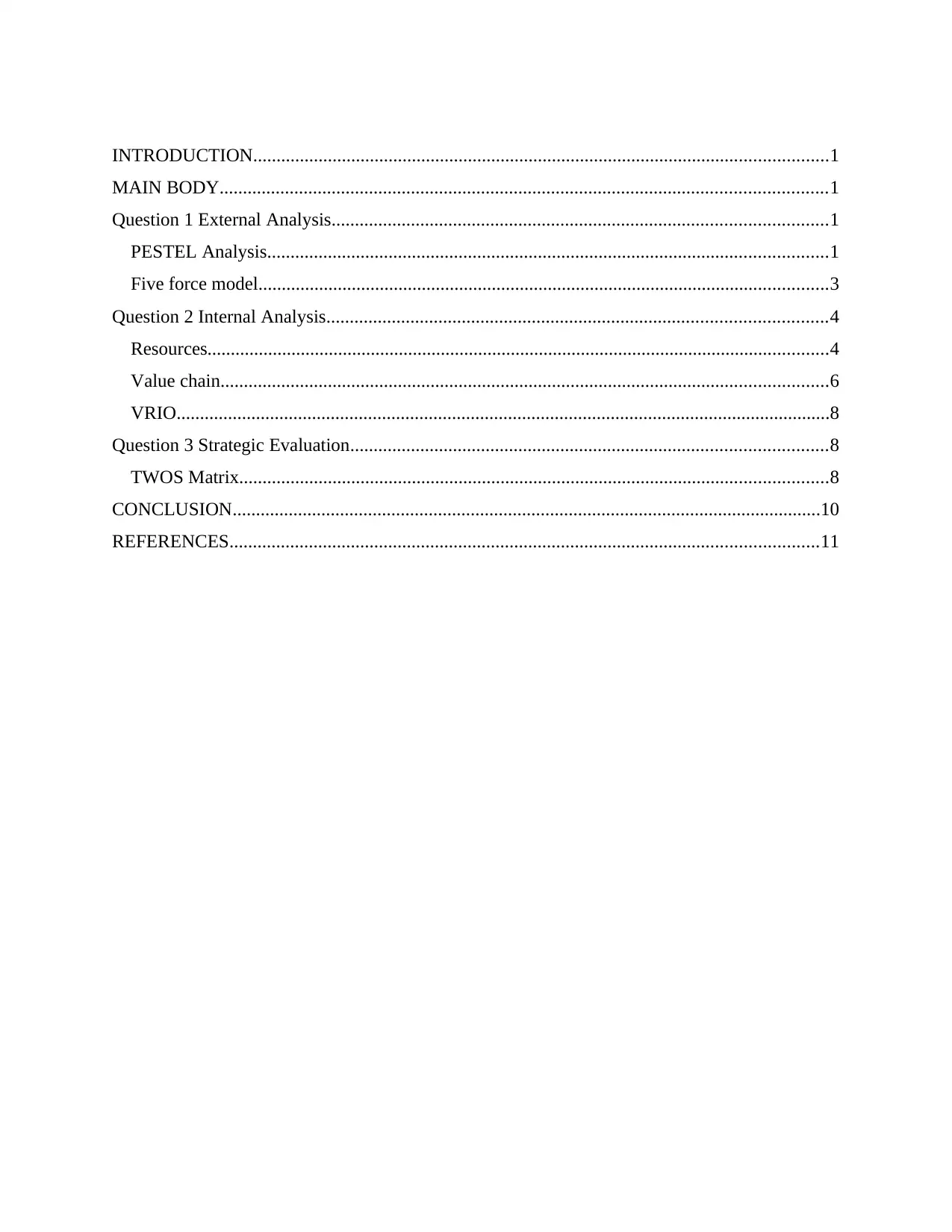
INTRODUCTION...........................................................................................................................1
MAIN BODY..................................................................................................................................1
Question 1 External Analysis..........................................................................................................1
PESTEL Analysis........................................................................................................................1
Five force model..........................................................................................................................3
Question 2 Internal Analysis...........................................................................................................4
Resources.....................................................................................................................................4
Value chain..................................................................................................................................6
VRIO............................................................................................................................................8
Question 3 Strategic Evaluation......................................................................................................8
TWOS Matrix..............................................................................................................................8
CONCLUSION..............................................................................................................................10
REFERENCES..............................................................................................................................11
MAIN BODY..................................................................................................................................1
Question 1 External Analysis..........................................................................................................1
PESTEL Analysis........................................................................................................................1
Five force model..........................................................................................................................3
Question 2 Internal Analysis...........................................................................................................4
Resources.....................................................................................................................................4
Value chain..................................................................................................................................6
VRIO............................................................................................................................................8
Question 3 Strategic Evaluation......................................................................................................8
TWOS Matrix..............................................................................................................................8
CONCLUSION..............................................................................................................................10
REFERENCES..............................................................................................................................11
Secure Best Marks with AI Grader
Need help grading? Try our AI Grader for instant feedback on your assignments.
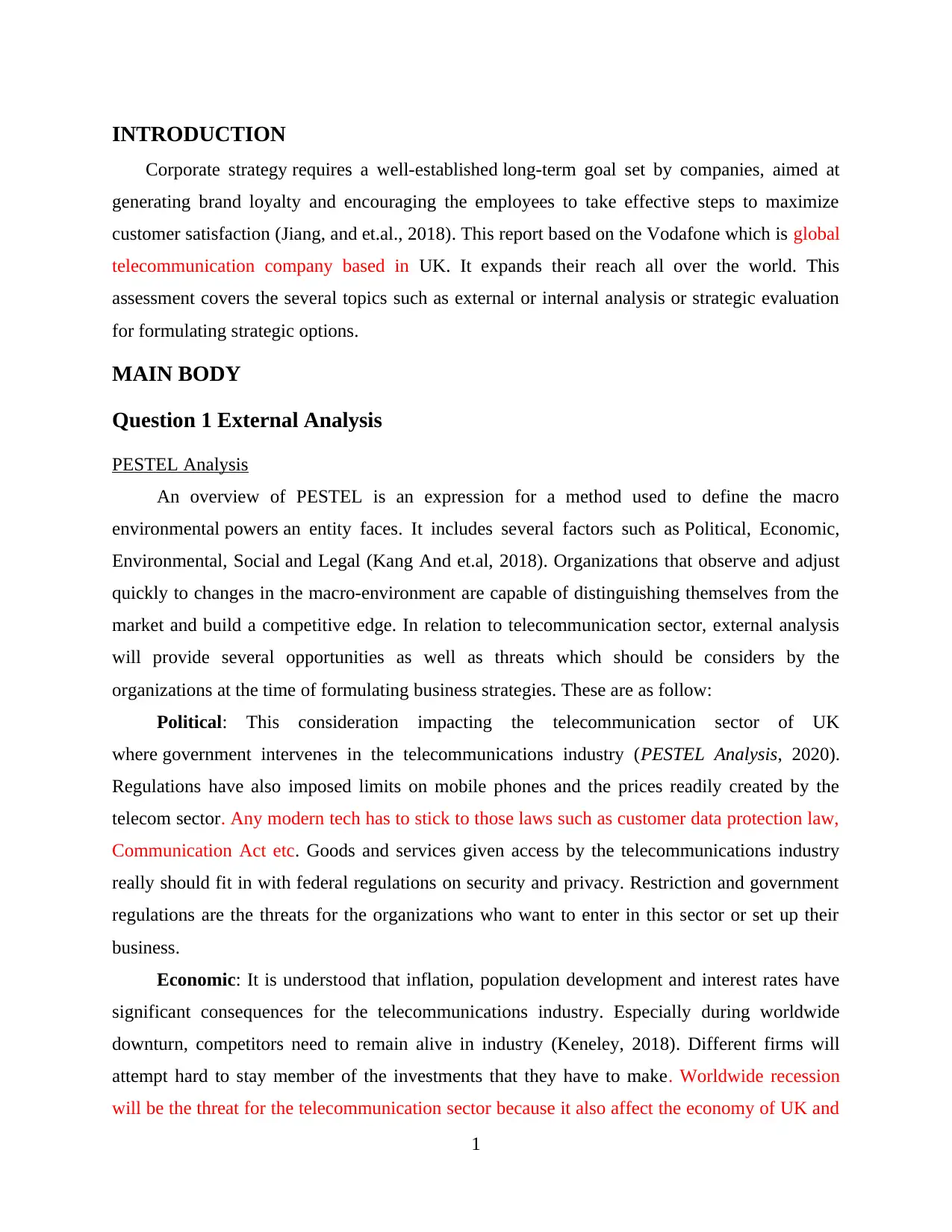
INTRODUCTION
Corporate strategy requires a well-established long-term goal set by companies, aimed at
generating brand loyalty and encouraging the employees to take effective steps to maximize
customer satisfaction (Jiang, and et.al., 2018). This report based on the Vodafone which is global
telecommunication company based in UK. It expands their reach all over the world. This
assessment covers the several topics such as external or internal analysis or strategic evaluation
for formulating strategic options.
MAIN BODY
Question 1 External Analysis
PESTEL Analysis
An overview of PESTEL is an expression for a method used to define the macro
environmental powers an entity faces. It includes several factors such as Political, Economic,
Environmental, Social and Legal (Kang And et.al, 2018). Organizations that observe and adjust
quickly to changes in the macro-environment are capable of distinguishing themselves from the
market and build a competitive edge. In relation to telecommunication sector, external analysis
will provide several opportunities as well as threats which should be considers by the
organizations at the time of formulating business strategies. These are as follow:
Political: This consideration impacting the telecommunication sector of UK
where government intervenes in the telecommunications industry (PESTEL Analysis, 2020).
Regulations have also imposed limits on mobile phones and the prices readily created by the
telecom sector. Any modern tech has to stick to those laws such as customer data protection law,
Communication Act etc. Goods and services given access by the telecommunications industry
really should fit in with federal regulations on security and privacy. Restriction and government
regulations are the threats for the organizations who want to enter in this sector or set up their
business.
Economic: It is understood that inflation, population development and interest rates have
significant consequences for the telecommunications industry. Especially during worldwide
downturn, competitors need to remain alive in industry (Keneley, 2018). Different firms will
attempt hard to stay member of the investments that they have to make. Worldwide recession
will be the threat for the telecommunication sector because it also affect the economy of UK and
1
Corporate strategy requires a well-established long-term goal set by companies, aimed at
generating brand loyalty and encouraging the employees to take effective steps to maximize
customer satisfaction (Jiang, and et.al., 2018). This report based on the Vodafone which is global
telecommunication company based in UK. It expands their reach all over the world. This
assessment covers the several topics such as external or internal analysis or strategic evaluation
for formulating strategic options.
MAIN BODY
Question 1 External Analysis
PESTEL Analysis
An overview of PESTEL is an expression for a method used to define the macro
environmental powers an entity faces. It includes several factors such as Political, Economic,
Environmental, Social and Legal (Kang And et.al, 2018). Organizations that observe and adjust
quickly to changes in the macro-environment are capable of distinguishing themselves from the
market and build a competitive edge. In relation to telecommunication sector, external analysis
will provide several opportunities as well as threats which should be considers by the
organizations at the time of formulating business strategies. These are as follow:
Political: This consideration impacting the telecommunication sector of UK
where government intervenes in the telecommunications industry (PESTEL Analysis, 2020).
Regulations have also imposed limits on mobile phones and the prices readily created by the
telecom sector. Any modern tech has to stick to those laws such as customer data protection law,
Communication Act etc. Goods and services given access by the telecommunications industry
really should fit in with federal regulations on security and privacy. Restriction and government
regulations are the threats for the organizations who want to enter in this sector or set up their
business.
Economic: It is understood that inflation, population development and interest rates have
significant consequences for the telecommunications industry. Especially during worldwide
downturn, competitors need to remain alive in industry (Keneley, 2018). Different firms will
attempt hard to stay member of the investments that they have to make. Worldwide recession
will be the threat for the telecommunication sector because it also affect the economy of UK and
1
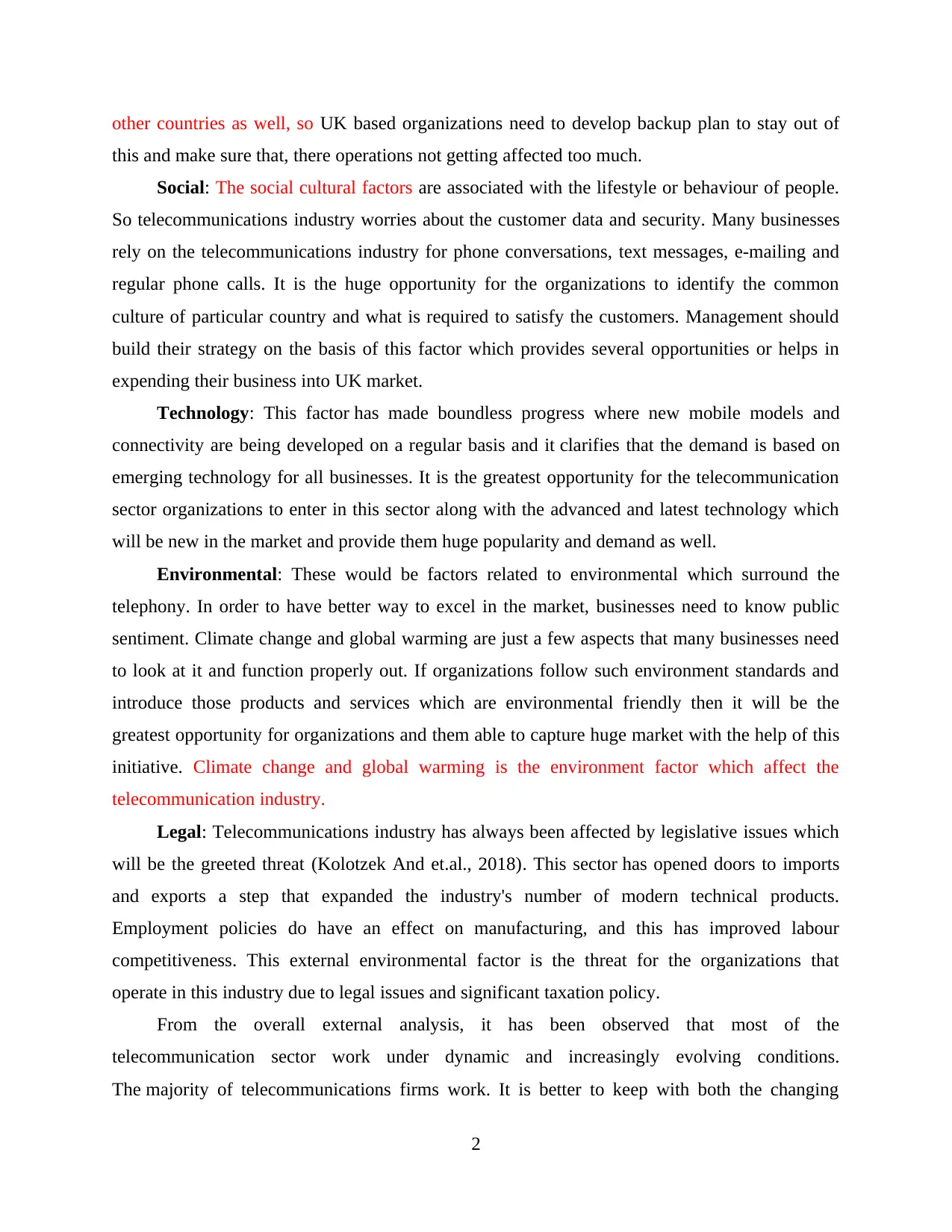
other countries as well, so UK based organizations need to develop backup plan to stay out of
this and make sure that, there operations not getting affected too much.
Social: The social cultural factors are associated with the lifestyle or behaviour of people.
So telecommunications industry worries about the customer data and security. Many businesses
rely on the telecommunications industry for phone conversations, text messages, e-mailing and
regular phone calls. It is the huge opportunity for the organizations to identify the common
culture of particular country and what is required to satisfy the customers. Management should
build their strategy on the basis of this factor which provides several opportunities or helps in
expending their business into UK market.
Technology: This factor has made boundless progress where new mobile models and
connectivity are being developed on a regular basis and it clarifies that the demand is based on
emerging technology for all businesses. It is the greatest opportunity for the telecommunication
sector organizations to enter in this sector along with the advanced and latest technology which
will be new in the market and provide them huge popularity and demand as well.
Environmental: These would be factors related to environmental which surround the
telephony. In order to have better way to excel in the market, businesses need to know public
sentiment. Climate change and global warming are just a few aspects that many businesses need
to look at it and function properly out. If organizations follow such environment standards and
introduce those products and services which are environmental friendly then it will be the
greatest opportunity for organizations and them able to capture huge market with the help of this
initiative. Climate change and global warming is the environment factor which affect the
telecommunication industry.
Legal: Telecommunications industry has always been affected by legislative issues which
will be the greeted threat (Kolotzek And et.al., 2018). This sector has opened doors to imports
and exports a step that expanded the industry's number of modern technical products.
Employment policies do have an effect on manufacturing, and this has improved labour
competitiveness. This external environmental factor is the threat for the organizations that
operate in this industry due to legal issues and significant taxation policy.
From the overall external analysis, it has been observed that most of the
telecommunication sector work under dynamic and increasingly evolving conditions.
The majority of telecommunications firms work. It is better to keep with both the changing
2
this and make sure that, there operations not getting affected too much.
Social: The social cultural factors are associated with the lifestyle or behaviour of people.
So telecommunications industry worries about the customer data and security. Many businesses
rely on the telecommunications industry for phone conversations, text messages, e-mailing and
regular phone calls. It is the huge opportunity for the organizations to identify the common
culture of particular country and what is required to satisfy the customers. Management should
build their strategy on the basis of this factor which provides several opportunities or helps in
expending their business into UK market.
Technology: This factor has made boundless progress where new mobile models and
connectivity are being developed on a regular basis and it clarifies that the demand is based on
emerging technology for all businesses. It is the greatest opportunity for the telecommunication
sector organizations to enter in this sector along with the advanced and latest technology which
will be new in the market and provide them huge popularity and demand as well.
Environmental: These would be factors related to environmental which surround the
telephony. In order to have better way to excel in the market, businesses need to know public
sentiment. Climate change and global warming are just a few aspects that many businesses need
to look at it and function properly out. If organizations follow such environment standards and
introduce those products and services which are environmental friendly then it will be the
greatest opportunity for organizations and them able to capture huge market with the help of this
initiative. Climate change and global warming is the environment factor which affect the
telecommunication industry.
Legal: Telecommunications industry has always been affected by legislative issues which
will be the greeted threat (Kolotzek And et.al., 2018). This sector has opened doors to imports
and exports a step that expanded the industry's number of modern technical products.
Employment policies do have an effect on manufacturing, and this has improved labour
competitiveness. This external environmental factor is the threat for the organizations that
operate in this industry due to legal issues and significant taxation policy.
From the overall external analysis, it has been observed that most of the
telecommunication sector work under dynamic and increasingly evolving conditions.
The majority of telecommunications firms work. It is better to keep with both the changing
2
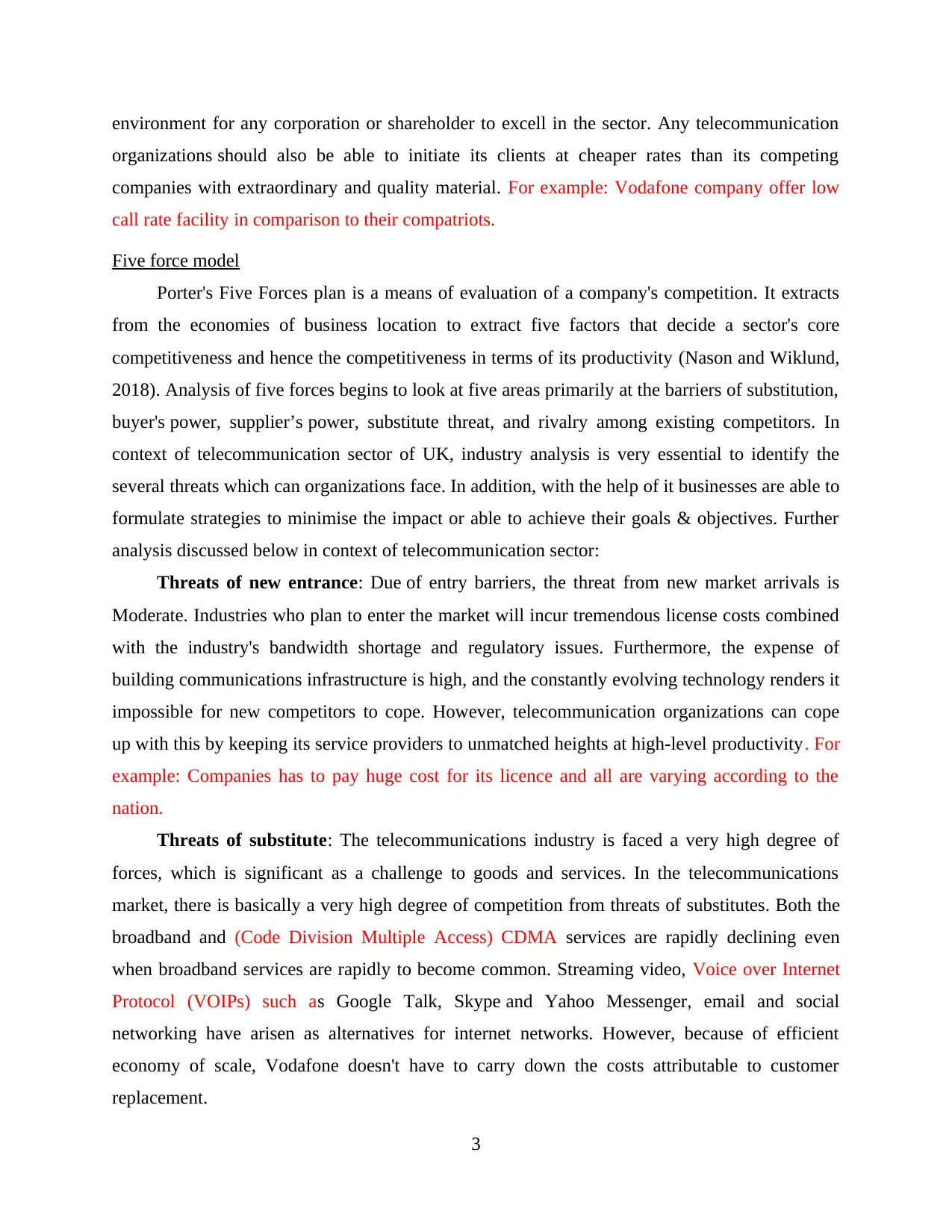
environment for any corporation or shareholder to excell in the sector. Any telecommunication
organizations should also be able to initiate its clients at cheaper rates than its competing
companies with extraordinary and quality material. For example: Vodafone company offer low
call rate facility in comparison to their compatriots.
Five force model
Porter's Five Forces plan is a means of evaluation of a company's competition. It extracts
from the economies of business location to extract five factors that decide a sector's core
competitiveness and hence the competitiveness in terms of its productivity (Nason and Wiklund,
2018). Analysis of five forces begins to look at five areas primarily at the barriers of substitution,
buyer's power, supplier’s power, substitute threat, and rivalry among existing competitors. In
context of telecommunication sector of UK, industry analysis is very essential to identify the
several threats which can organizations face. In addition, with the help of it businesses are able to
formulate strategies to minimise the impact or able to achieve their goals & objectives. Further
analysis discussed below in context of telecommunication sector:
Threats of new entrance: Due of entry barriers, the threat from new market arrivals is
Moderate. Industries who plan to enter the market will incur tremendous license costs combined
with the industry's bandwidth shortage and regulatory issues. Furthermore, the expense of
building communications infrastructure is high, and the constantly evolving technology renders it
impossible for new competitors to cope. However, telecommunication organizations can cope
up with this by keeping its service providers to unmatched heights at high-level productivity. For
example: Companies has to pay huge cost for its licence and all are varying according to the
nation.
Threats of substitute: The telecommunications industry is faced a very high degree of
forces, which is significant as a challenge to goods and services. In the telecommunications
market, there is basically a very high degree of competition from threats of substitutes. Both the
broadband and (Code Division Multiple Access) CDMA services are rapidly declining even
when broadband services are rapidly to become common. Streaming video, Voice over Internet
Protocol (VOIPs) such as Google Talk, Skype and Yahoo Messenger, email and social
networking have arisen as alternatives for internet networks. However, because of efficient
economy of scale, Vodafone doesn't have to carry down the costs attributable to customer
replacement.
3
organizations should also be able to initiate its clients at cheaper rates than its competing
companies with extraordinary and quality material. For example: Vodafone company offer low
call rate facility in comparison to their compatriots.
Five force model
Porter's Five Forces plan is a means of evaluation of a company's competition. It extracts
from the economies of business location to extract five factors that decide a sector's core
competitiveness and hence the competitiveness in terms of its productivity (Nason and Wiklund,
2018). Analysis of five forces begins to look at five areas primarily at the barriers of substitution,
buyer's power, supplier’s power, substitute threat, and rivalry among existing competitors. In
context of telecommunication sector of UK, industry analysis is very essential to identify the
several threats which can organizations face. In addition, with the help of it businesses are able to
formulate strategies to minimise the impact or able to achieve their goals & objectives. Further
analysis discussed below in context of telecommunication sector:
Threats of new entrance: Due of entry barriers, the threat from new market arrivals is
Moderate. Industries who plan to enter the market will incur tremendous license costs combined
with the industry's bandwidth shortage and regulatory issues. Furthermore, the expense of
building communications infrastructure is high, and the constantly evolving technology renders it
impossible for new competitors to cope. However, telecommunication organizations can cope
up with this by keeping its service providers to unmatched heights at high-level productivity. For
example: Companies has to pay huge cost for its licence and all are varying according to the
nation.
Threats of substitute: The telecommunications industry is faced a very high degree of
forces, which is significant as a challenge to goods and services. In the telecommunications
market, there is basically a very high degree of competition from threats of substitutes. Both the
broadband and (Code Division Multiple Access) CDMA services are rapidly declining even
when broadband services are rapidly to become common. Streaming video, Voice over Internet
Protocol (VOIPs) such as Google Talk, Skype and Yahoo Messenger, email and social
networking have arisen as alternatives for internet networks. However, because of efficient
economy of scale, Vodafone doesn't have to carry down the costs attributable to customer
replacement.
3
Secure Best Marks with AI Grader
Need help grading? Try our AI Grader for instant feedback on your assignments.
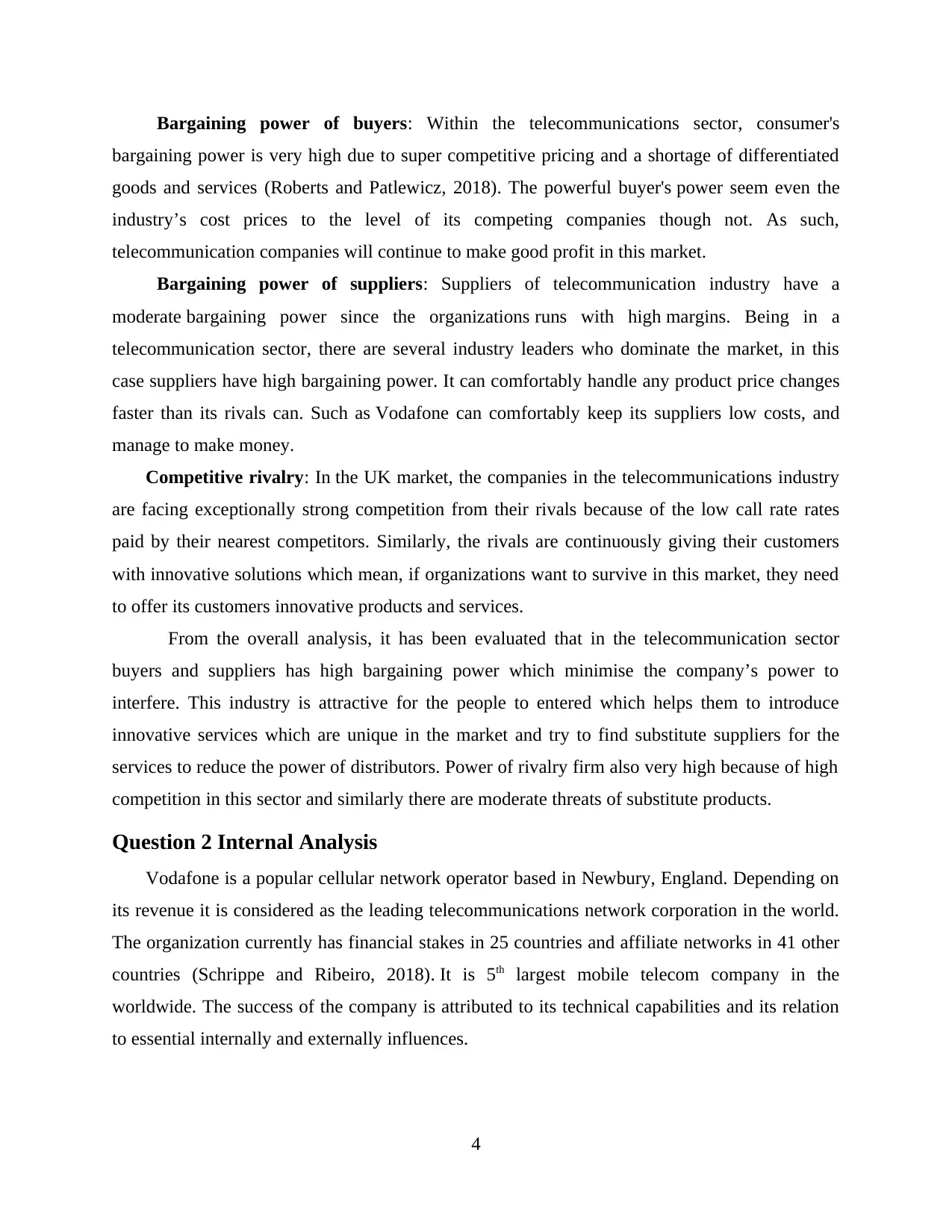
Bargaining power of buyers: Within the telecommunications sector, consumer's
bargaining power is very high due to super competitive pricing and a shortage of differentiated
goods and services (Roberts and Patlewicz, 2018). The powerful buyer's power seem even the
industry’s cost prices to the level of its competing companies though not. As such,
telecommunication companies will continue to make good profit in this market.
Bargaining power of suppliers: Suppliers of telecommunication industry have a
moderate bargaining power since the organizations runs with high margins. Being in a
telecommunication sector, there are several industry leaders who dominate the market, in this
case suppliers have high bargaining power. It can comfortably handle any product price changes
faster than its rivals can. Such as Vodafone can comfortably keep its suppliers low costs, and
manage to make money.
Competitive rivalry: In the UK market, the companies in the telecommunications industry
are facing exceptionally strong competition from their rivals because of the low call rate rates
paid by their nearest competitors. Similarly, the rivals are continuously giving their customers
with innovative solutions which mean, if organizations want to survive in this market, they need
to offer its customers innovative products and services.
From the overall analysis, it has been evaluated that in the telecommunication sector
buyers and suppliers has high bargaining power which minimise the company’s power to
interfere. This industry is attractive for the people to entered which helps them to introduce
innovative services which are unique in the market and try to find substitute suppliers for the
services to reduce the power of distributors. Power of rivalry firm also very high because of high
competition in this sector and similarly there are moderate threats of substitute products.
Question 2 Internal Analysis
Vodafone is a popular cellular network operator based in Newbury, England. Depending on
its revenue it is considered as the leading telecommunications network corporation in the world.
The organization currently has financial stakes in 25 countries and affiliate networks in 41 other
countries (Schrippe and Ribeiro, 2018). It is 5th largest mobile telecom company in the
worldwide. The success of the company is attributed to its technical capabilities and its relation
to essential internally and externally influences.
4
bargaining power is very high due to super competitive pricing and a shortage of differentiated
goods and services (Roberts and Patlewicz, 2018). The powerful buyer's power seem even the
industry’s cost prices to the level of its competing companies though not. As such,
telecommunication companies will continue to make good profit in this market.
Bargaining power of suppliers: Suppliers of telecommunication industry have a
moderate bargaining power since the organizations runs with high margins. Being in a
telecommunication sector, there are several industry leaders who dominate the market, in this
case suppliers have high bargaining power. It can comfortably handle any product price changes
faster than its rivals can. Such as Vodafone can comfortably keep its suppliers low costs, and
manage to make money.
Competitive rivalry: In the UK market, the companies in the telecommunications industry
are facing exceptionally strong competition from their rivals because of the low call rate rates
paid by their nearest competitors. Similarly, the rivals are continuously giving their customers
with innovative solutions which mean, if organizations want to survive in this market, they need
to offer its customers innovative products and services.
From the overall analysis, it has been evaluated that in the telecommunication sector
buyers and suppliers has high bargaining power which minimise the company’s power to
interfere. This industry is attractive for the people to entered which helps them to introduce
innovative services which are unique in the market and try to find substitute suppliers for the
services to reduce the power of distributors. Power of rivalry firm also very high because of high
competition in this sector and similarly there are moderate threats of substitute products.
Question 2 Internal Analysis
Vodafone is a popular cellular network operator based in Newbury, England. Depending on
its revenue it is considered as the leading telecommunications network corporation in the world.
The organization currently has financial stakes in 25 countries and affiliate networks in 41 other
countries (Schrippe and Ribeiro, 2018). It is 5th largest mobile telecom company in the
worldwide. The success of the company is attributed to its technical capabilities and its relation
to essential internally and externally influences.
4
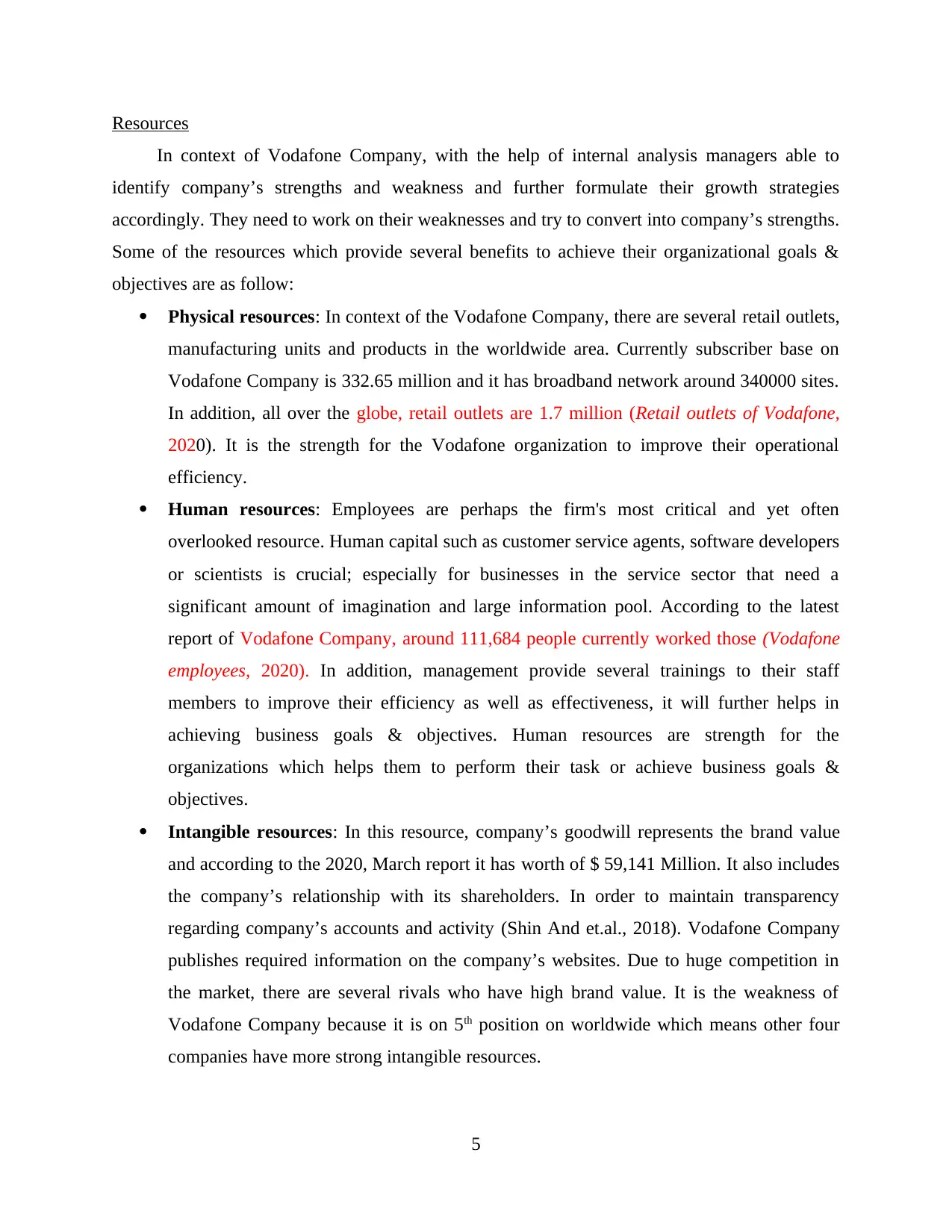
Resources
In context of Vodafone Company, with the help of internal analysis managers able to
identify company’s strengths and weakness and further formulate their growth strategies
accordingly. They need to work on their weaknesses and try to convert into company’s strengths.
Some of the resources which provide several benefits to achieve their organizational goals &
objectives are as follow:
Physical resources: In context of the Vodafone Company, there are several retail outlets,
manufacturing units and products in the worldwide area. Currently subscriber base on
Vodafone Company is 332.65 million and it has broadband network around 340000 sites.
In addition, all over the globe, retail outlets are 1.7 million (Retail outlets of Vodafone,
2020). It is the strength for the Vodafone organization to improve their operational
efficiency.
Human resources: Employees are perhaps the firm's most critical and yet often
overlooked resource. Human capital such as customer service agents, software developers
or scientists is crucial; especially for businesses in the service sector that need a
significant amount of imagination and large information pool. According to the latest
report of Vodafone Company, around 111,684 people currently worked those (Vodafone
employees, 2020). In addition, management provide several trainings to their staff
members to improve their efficiency as well as effectiveness, it will further helps in
achieving business goals & objectives. Human resources are strength for the
organizations which helps them to perform their task or achieve business goals &
objectives.
Intangible resources: In this resource, company’s goodwill represents the brand value
and according to the 2020, March report it has worth of $ 59,141 Million. It also includes
the company’s relationship with its shareholders. In order to maintain transparency
regarding company’s accounts and activity (Shin And et.al., 2018). Vodafone Company
publishes required information on the company’s websites. Due to huge competition in
the market, there are several rivals who have high brand value. It is the weakness of
Vodafone Company because it is on 5th position on worldwide which means other four
companies have more strong intangible resources.
5
In context of Vodafone Company, with the help of internal analysis managers able to
identify company’s strengths and weakness and further formulate their growth strategies
accordingly. They need to work on their weaknesses and try to convert into company’s strengths.
Some of the resources which provide several benefits to achieve their organizational goals &
objectives are as follow:
Physical resources: In context of the Vodafone Company, there are several retail outlets,
manufacturing units and products in the worldwide area. Currently subscriber base on
Vodafone Company is 332.65 million and it has broadband network around 340000 sites.
In addition, all over the globe, retail outlets are 1.7 million (Retail outlets of Vodafone,
2020). It is the strength for the Vodafone organization to improve their operational
efficiency.
Human resources: Employees are perhaps the firm's most critical and yet often
overlooked resource. Human capital such as customer service agents, software developers
or scientists is crucial; especially for businesses in the service sector that need a
significant amount of imagination and large information pool. According to the latest
report of Vodafone Company, around 111,684 people currently worked those (Vodafone
employees, 2020). In addition, management provide several trainings to their staff
members to improve their efficiency as well as effectiveness, it will further helps in
achieving business goals & objectives. Human resources are strength for the
organizations which helps them to perform their task or achieve business goals &
objectives.
Intangible resources: In this resource, company’s goodwill represents the brand value
and according to the 2020, March report it has worth of $ 59,141 Million. It also includes
the company’s relationship with its shareholders. In order to maintain transparency
regarding company’s accounts and activity (Shin And et.al., 2018). Vodafone Company
publishes required information on the company’s websites. Due to huge competition in
the market, there are several rivals who have high brand value. It is the weakness of
Vodafone Company because it is on 5th position on worldwide which means other four
companies have more strong intangible resources.
5
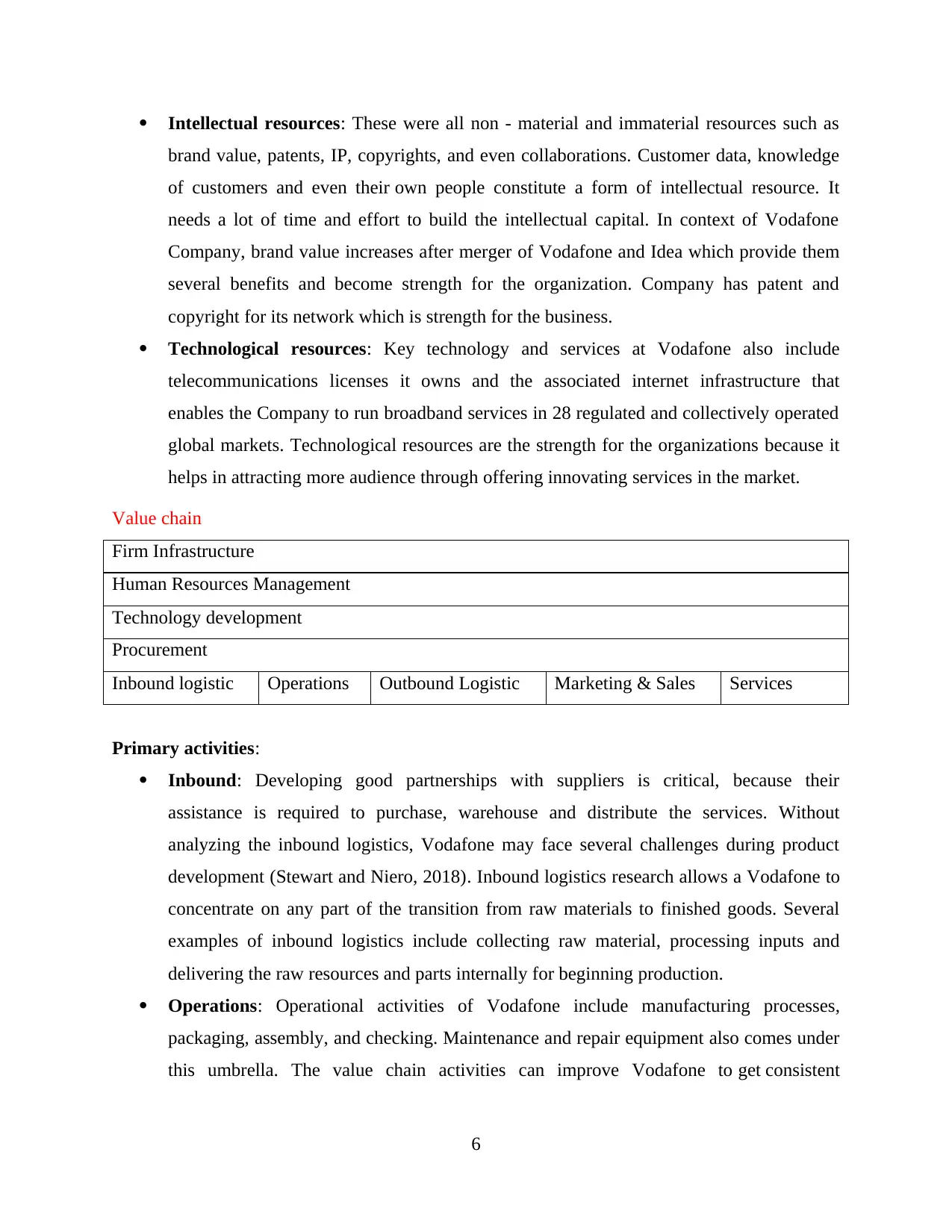
Intellectual resources: These were all non - material and immaterial resources such as
brand value, patents, IP, copyrights, and even collaborations. Customer data, knowledge
of customers and even their own people constitute a form of intellectual resource. It
needs a lot of time and effort to build the intellectual capital. In context of Vodafone
Company, brand value increases after merger of Vodafone and Idea which provide them
several benefits and become strength for the organization. Company has patent and
copyright for its network which is strength for the business.
Technological resources: Key technology and services at Vodafone also include
telecommunications licenses it owns and the associated internet infrastructure that
enables the Company to run broadband services in 28 regulated and collectively operated
global markets. Technological resources are the strength for the organizations because it
helps in attracting more audience through offering innovating services in the market.
Value chain
Firm Infrastructure
Human Resources Management
Technology development
Procurement
Inbound logistic Operations Outbound Logistic Marketing & Sales Services
Primary activities:
Inbound: Developing good partnerships with suppliers is critical, because their
assistance is required to purchase, warehouse and distribute the services. Without
analyzing the inbound logistics, Vodafone may face several challenges during product
development (Stewart and Niero, 2018). Inbound logistics research allows a Vodafone to
concentrate on any part of the transition from raw materials to finished goods. Several
examples of inbound logistics include collecting raw material, processing inputs and
delivering the raw resources and parts internally for beginning production.
Operations: Operational activities of Vodafone include manufacturing processes,
packaging, assembly, and checking. Maintenance and repair equipment also comes under
this umbrella. The value chain activities can improve Vodafone to get consistent
6
brand value, patents, IP, copyrights, and even collaborations. Customer data, knowledge
of customers and even their own people constitute a form of intellectual resource. It
needs a lot of time and effort to build the intellectual capital. In context of Vodafone
Company, brand value increases after merger of Vodafone and Idea which provide them
several benefits and become strength for the organization. Company has patent and
copyright for its network which is strength for the business.
Technological resources: Key technology and services at Vodafone also include
telecommunications licenses it owns and the associated internet infrastructure that
enables the Company to run broadband services in 28 regulated and collectively operated
global markets. Technological resources are the strength for the organizations because it
helps in attracting more audience through offering innovating services in the market.
Value chain
Firm Infrastructure
Human Resources Management
Technology development
Procurement
Inbound logistic Operations Outbound Logistic Marketing & Sales Services
Primary activities:
Inbound: Developing good partnerships with suppliers is critical, because their
assistance is required to purchase, warehouse and distribute the services. Without
analyzing the inbound logistics, Vodafone may face several challenges during product
development (Stewart and Niero, 2018). Inbound logistics research allows a Vodafone to
concentrate on any part of the transition from raw materials to finished goods. Several
examples of inbound logistics include collecting raw material, processing inputs and
delivering the raw resources and parts internally for beginning production.
Operations: Operational activities of Vodafone include manufacturing processes,
packaging, assembly, and checking. Maintenance and repair equipment also comes under
this umbrella. The value chain activities can improve Vodafone to get consistent
6
Paraphrase This Document
Need a fresh take? Get an instant paraphrase of this document with our AI Paraphraser
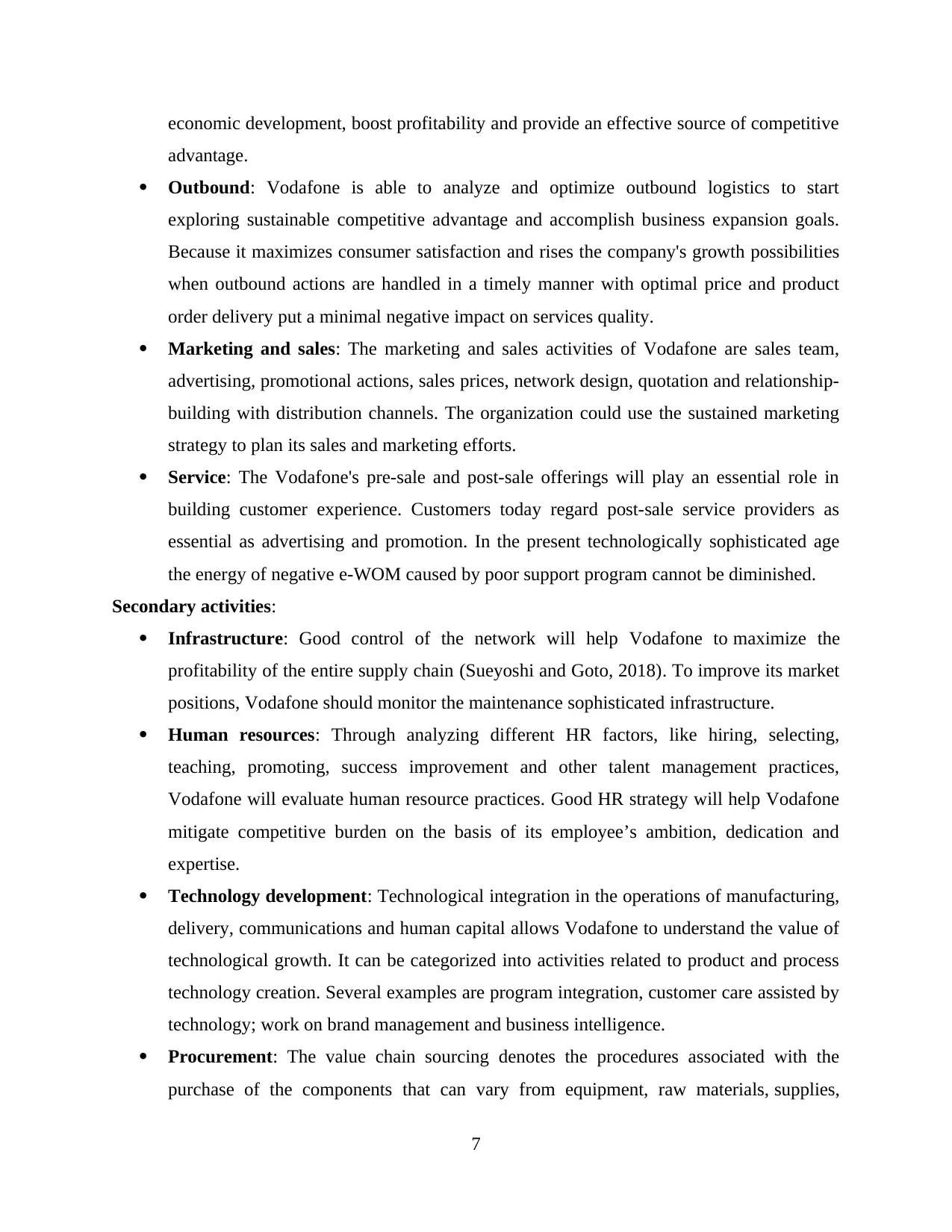
economic development, boost profitability and provide an effective source of competitive
advantage.
Outbound: Vodafone is able to analyze and optimize outbound logistics to start
exploring sustainable competitive advantage and accomplish business expansion goals.
Because it maximizes consumer satisfaction and rises the company's growth possibilities
when outbound actions are handled in a timely manner with optimal price and product
order delivery put a minimal negative impact on services quality.
Marketing and sales: The marketing and sales activities of Vodafone are sales team,
advertising, promotional actions, sales prices, network design, quotation and relationship-
building with distribution channels. The organization could use the sustained marketing
strategy to plan its sales and marketing efforts.
Service: The Vodafone's pre-sale and post-sale offerings will play an essential role in
building customer experience. Customers today regard post-sale service providers as
essential as advertising and promotion. In the present technologically sophisticated age
the energy of negative e-WOM caused by poor support program cannot be diminished.
Secondary activities:
Infrastructure: Good control of the network will help Vodafone to maximize the
profitability of the entire supply chain (Sueyoshi and Goto, 2018). To improve its market
positions, Vodafone should monitor the maintenance sophisticated infrastructure.
Human resources: Through analyzing different HR factors, like hiring, selecting,
teaching, promoting, success improvement and other talent management practices,
Vodafone will evaluate human resource practices. Good HR strategy will help Vodafone
mitigate competitive burden on the basis of its employee’s ambition, dedication and
expertise.
Technology development: Technological integration in the operations of manufacturing,
delivery, communications and human capital allows Vodafone to understand the value of
technological growth. It can be categorized into activities related to product and process
technology creation. Several examples are program integration, customer care assisted by
technology; work on brand management and business intelligence.
Procurement: The value chain sourcing denotes the procedures associated with the
purchase of the components that can vary from equipment, raw materials, supplies,
7
advantage.
Outbound: Vodafone is able to analyze and optimize outbound logistics to start
exploring sustainable competitive advantage and accomplish business expansion goals.
Because it maximizes consumer satisfaction and rises the company's growth possibilities
when outbound actions are handled in a timely manner with optimal price and product
order delivery put a minimal negative impact on services quality.
Marketing and sales: The marketing and sales activities of Vodafone are sales team,
advertising, promotional actions, sales prices, network design, quotation and relationship-
building with distribution channels. The organization could use the sustained marketing
strategy to plan its sales and marketing efforts.
Service: The Vodafone's pre-sale and post-sale offerings will play an essential role in
building customer experience. Customers today regard post-sale service providers as
essential as advertising and promotion. In the present technologically sophisticated age
the energy of negative e-WOM caused by poor support program cannot be diminished.
Secondary activities:
Infrastructure: Good control of the network will help Vodafone to maximize the
profitability of the entire supply chain (Sueyoshi and Goto, 2018). To improve its market
positions, Vodafone should monitor the maintenance sophisticated infrastructure.
Human resources: Through analyzing different HR factors, like hiring, selecting,
teaching, promoting, success improvement and other talent management practices,
Vodafone will evaluate human resource practices. Good HR strategy will help Vodafone
mitigate competitive burden on the basis of its employee’s ambition, dedication and
expertise.
Technology development: Technological integration in the operations of manufacturing,
delivery, communications and human capital allows Vodafone to understand the value of
technological growth. It can be categorized into activities related to product and process
technology creation. Several examples are program integration, customer care assisted by
technology; work on brand management and business intelligence.
Procurement: The value chain sourcing denotes the procedures associated with the
purchase of the components that can vary from equipment, raw materials, supplies,
7
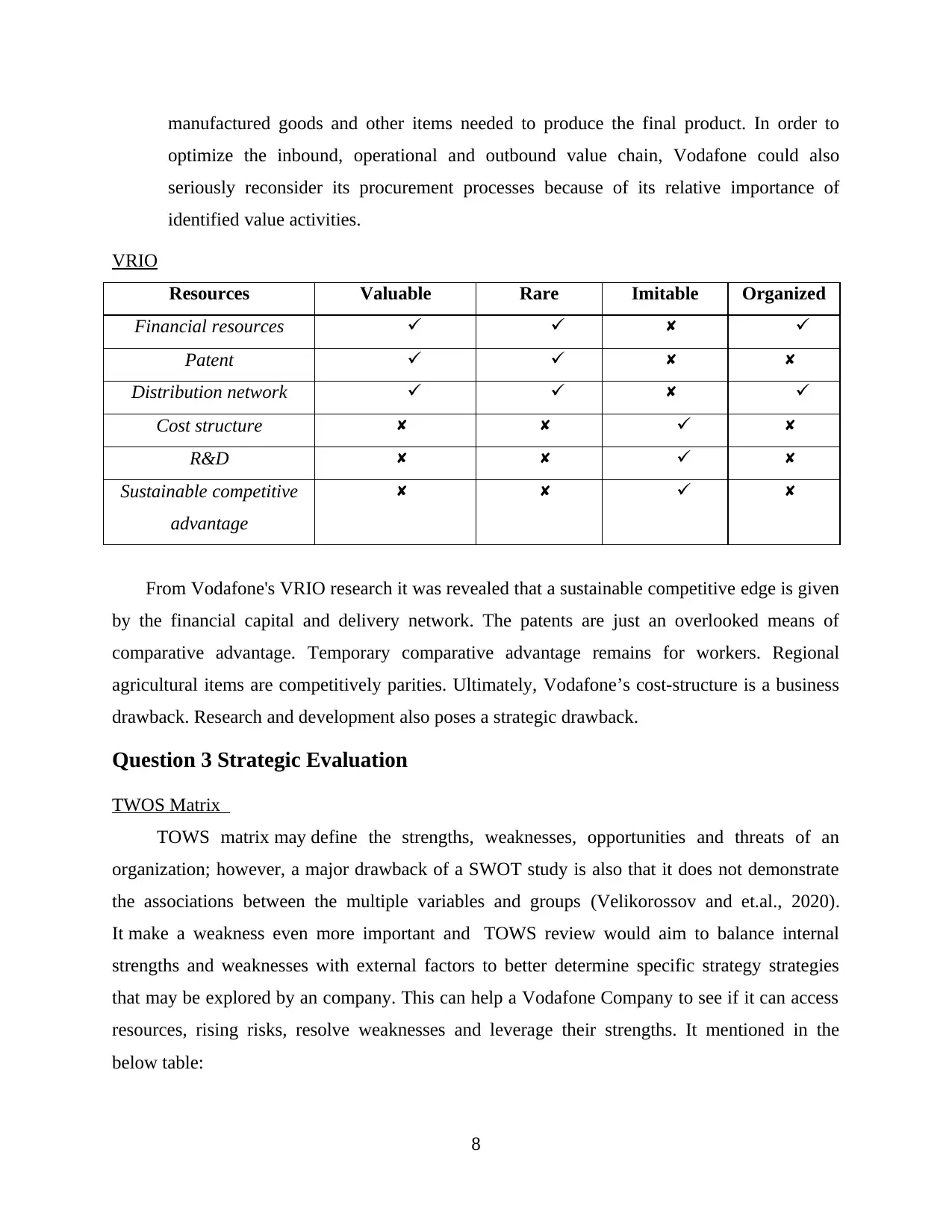
manufactured goods and other items needed to produce the final product. In order to
optimize the inbound, operational and outbound value chain, Vodafone could also
seriously reconsider its procurement processes because of its relative importance of
identified value activities.
VRIO
Resources Valuable Rare Imitable Organized
Financial resources
Patent
Distribution network
Cost structure
R&D
Sustainable competitive
advantage
From Vodafone's VRIO research it was revealed that a sustainable competitive edge is given
by the financial capital and delivery network. The patents are just an overlooked means of
comparative advantage. Temporary comparative advantage remains for workers. Regional
agricultural items are competitively parities. Ultimately, Vodafone’s cost-structure is a business
drawback. Research and development also poses a strategic drawback.
Question 3 Strategic Evaluation
TWOS Matrix
TOWS matrix may define the strengths, weaknesses, opportunities and threats of an
organization; however, a major drawback of a SWOT study is also that it does not demonstrate
the associations between the multiple variables and groups (Velikorossov and et.al., 2020).
It make a weakness even more important and TOWS review would aim to balance internal
strengths and weaknesses with external factors to better determine specific strategy strategies
that may be explored by an company. This can help a Vodafone Company to see if it can access
resources, rising risks, resolve weaknesses and leverage their strengths. It mentioned in the
below table:
8
optimize the inbound, operational and outbound value chain, Vodafone could also
seriously reconsider its procurement processes because of its relative importance of
identified value activities.
VRIO
Resources Valuable Rare Imitable Organized
Financial resources
Patent
Distribution network
Cost structure
R&D
Sustainable competitive
advantage
From Vodafone's VRIO research it was revealed that a sustainable competitive edge is given
by the financial capital and delivery network. The patents are just an overlooked means of
comparative advantage. Temporary comparative advantage remains for workers. Regional
agricultural items are competitively parities. Ultimately, Vodafone’s cost-structure is a business
drawback. Research and development also poses a strategic drawback.
Question 3 Strategic Evaluation
TWOS Matrix
TOWS matrix may define the strengths, weaknesses, opportunities and threats of an
organization; however, a major drawback of a SWOT study is also that it does not demonstrate
the associations between the multiple variables and groups (Velikorossov and et.al., 2020).
It make a weakness even more important and TOWS review would aim to balance internal
strengths and weaknesses with external factors to better determine specific strategy strategies
that may be explored by an company. This can help a Vodafone Company to see if it can access
resources, rising risks, resolve weaknesses and leverage their strengths. It mentioned in the
below table:
8
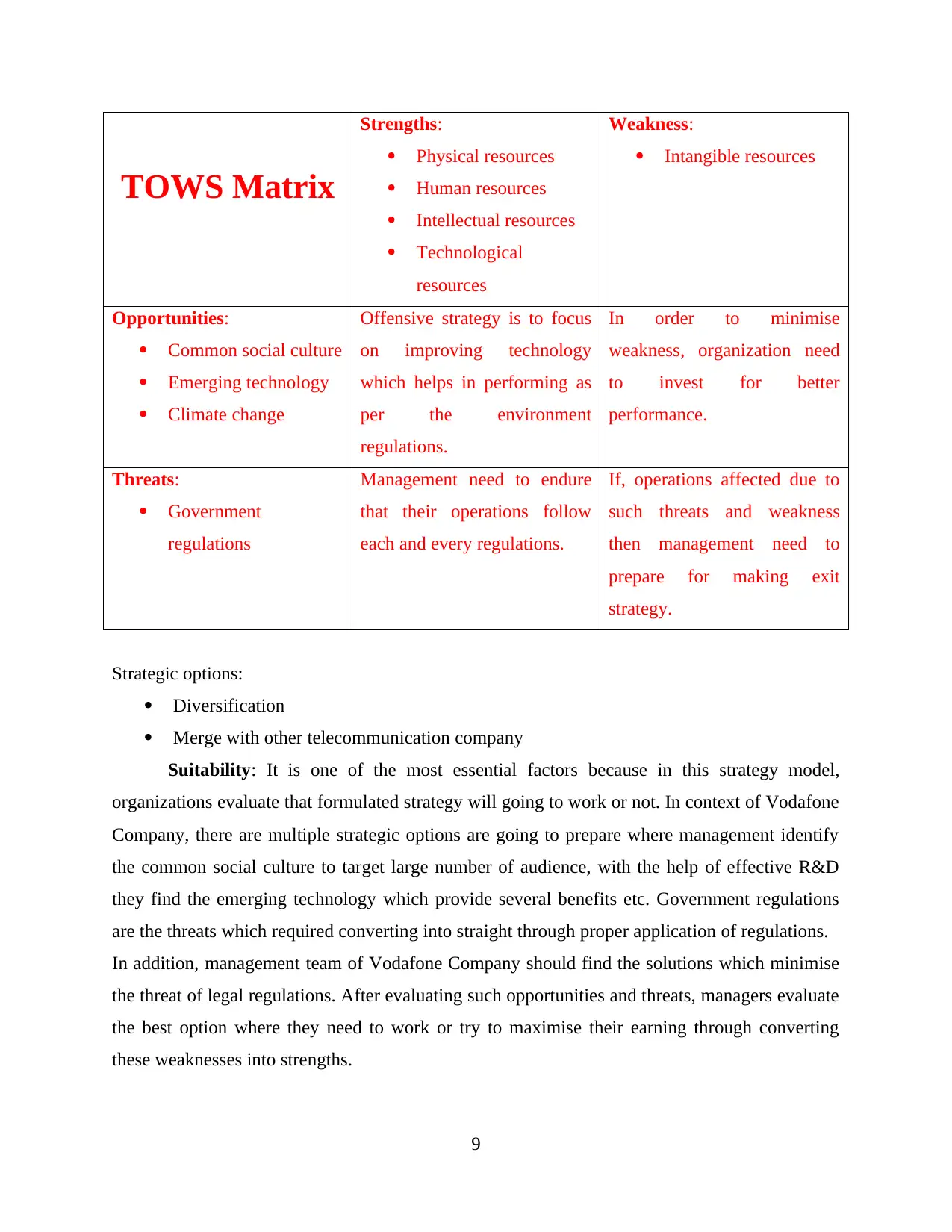
TOWS Matrix
Strengths:
Physical resources
Human resources
Intellectual resources
Technological
resources
Weakness:
Intangible resources
Opportunities:
Common social culture
Emerging technology
Climate change
Offensive strategy is to focus
on improving technology
which helps in performing as
per the environment
regulations.
In order to minimise
weakness, organization need
to invest for better
performance.
Threats:
Government
regulations
Management need to endure
that their operations follow
each and every regulations.
If, operations affected due to
such threats and weakness
then management need to
prepare for making exit
strategy.
Strategic options:
Diversification
Merge with other telecommunication company
Suitability: It is one of the most essential factors because in this strategy model,
organizations evaluate that formulated strategy will going to work or not. In context of Vodafone
Company, there are multiple strategic options are going to prepare where management identify
the common social culture to target large number of audience, with the help of effective R&D
they find the emerging technology which provide several benefits etc. Government regulations
are the threats which required converting into straight through proper application of regulations.
In addition, management team of Vodafone Company should find the solutions which minimise
the threat of legal regulations. After evaluating such opportunities and threats, managers evaluate
the best option where they need to work or try to maximise their earning through converting
these weaknesses into strengths.
9
Strengths:
Physical resources
Human resources
Intellectual resources
Technological
resources
Weakness:
Intangible resources
Opportunities:
Common social culture
Emerging technology
Climate change
Offensive strategy is to focus
on improving technology
which helps in performing as
per the environment
regulations.
In order to minimise
weakness, organization need
to invest for better
performance.
Threats:
Government
regulations
Management need to endure
that their operations follow
each and every regulations.
If, operations affected due to
such threats and weakness
then management need to
prepare for making exit
strategy.
Strategic options:
Diversification
Merge with other telecommunication company
Suitability: It is one of the most essential factors because in this strategy model,
organizations evaluate that formulated strategy will going to work or not. In context of Vodafone
Company, there are multiple strategic options are going to prepare where management identify
the common social culture to target large number of audience, with the help of effective R&D
they find the emerging technology which provide several benefits etc. Government regulations
are the threats which required converting into straight through proper application of regulations.
In addition, management team of Vodafone Company should find the solutions which minimise
the threat of legal regulations. After evaluating such opportunities and threats, managers evaluate
the best option where they need to work or try to maximise their earning through converting
these weaknesses into strengths.
9
Secure Best Marks with AI Grader
Need help grading? Try our AI Grader for instant feedback on your assignments.
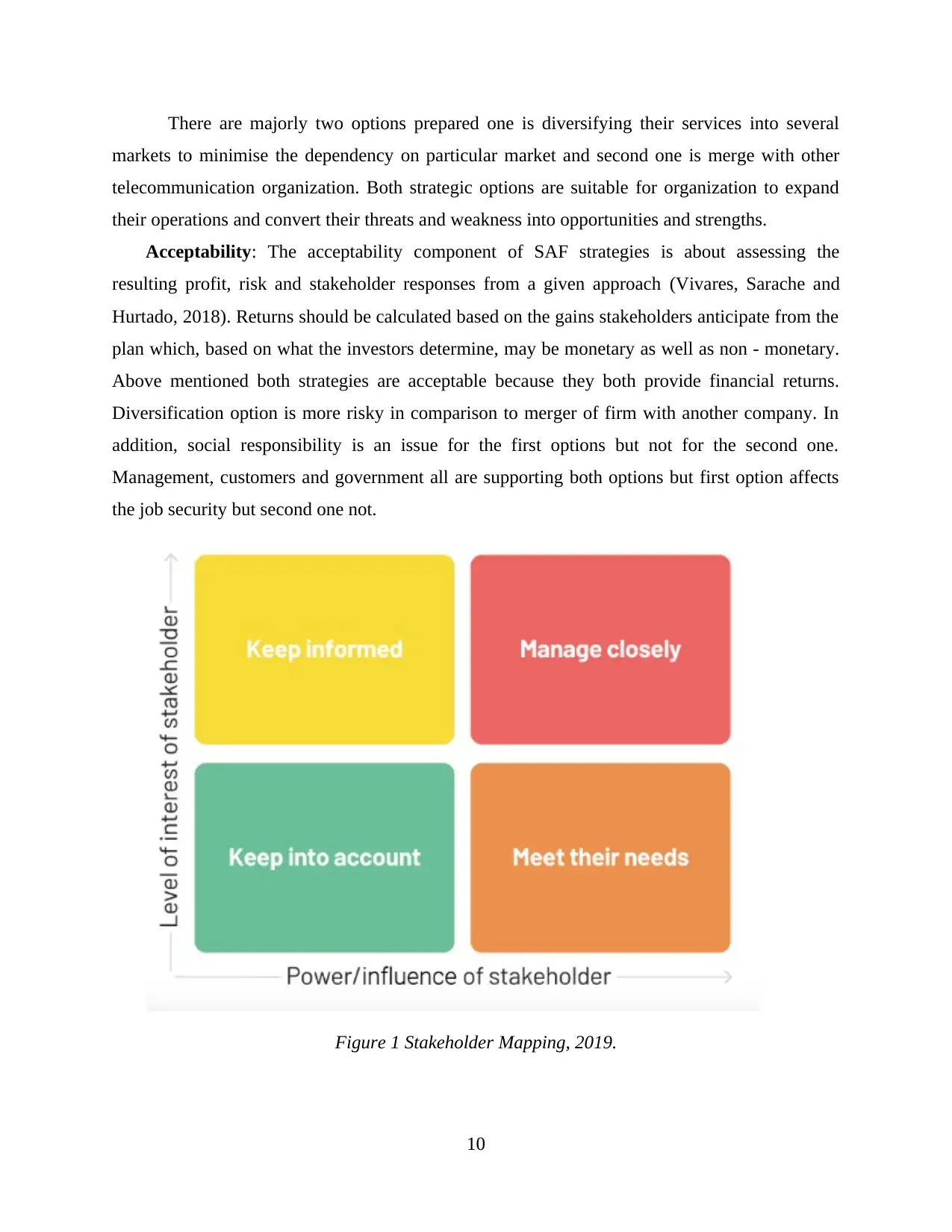
There are majorly two options prepared one is diversifying their services into several
markets to minimise the dependency on particular market and second one is merge with other
telecommunication organization. Both strategic options are suitable for organization to expand
their operations and convert their threats and weakness into opportunities and strengths.
Acceptability: The acceptability component of SAF strategies is about assessing the
resulting profit, risk and stakeholder responses from a given approach (Vivares, Sarache and
Hurtado, 2018). Returns should be calculated based on the gains stakeholders anticipate from the
plan which, based on what the investors determine, may be monetary as well as non - monetary.
Above mentioned both strategies are acceptable because they both provide financial returns.
Diversification option is more risky in comparison to merger of firm with another company. In
addition, social responsibility is an issue for the first options but not for the second one.
Management, customers and government all are supporting both options but first option affects
the job security but second one not.
Figure 1 Stakeholder Mapping, 2019.
10
markets to minimise the dependency on particular market and second one is merge with other
telecommunication organization. Both strategic options are suitable for organization to expand
their operations and convert their threats and weakness into opportunities and strengths.
Acceptability: The acceptability component of SAF strategies is about assessing the
resulting profit, risk and stakeholder responses from a given approach (Vivares, Sarache and
Hurtado, 2018). Returns should be calculated based on the gains stakeholders anticipate from the
plan which, based on what the investors determine, may be monetary as well as non - monetary.
Above mentioned both strategies are acceptable because they both provide financial returns.
Diversification option is more risky in comparison to merger of firm with another company. In
addition, social responsibility is an issue for the first options but not for the second one.
Management, customers and government all are supporting both options but first option affects
the job security but second one not.
Figure 1 Stakeholder Mapping, 2019.
10
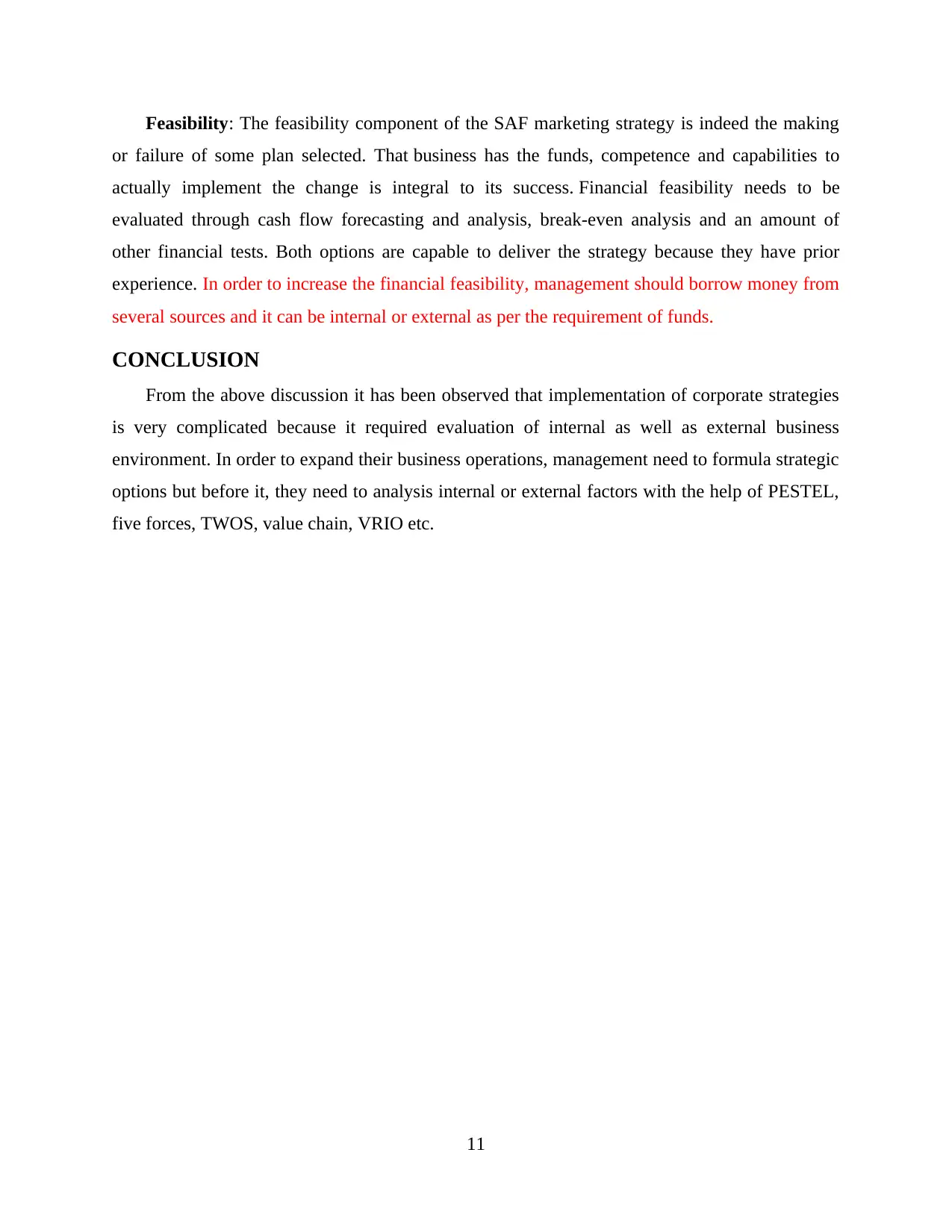
Feasibility: The feasibility component of the SAF marketing strategy is indeed the making
or failure of some plan selected. That business has the funds, competence and capabilities to
actually implement the change is integral to its success. Financial feasibility needs to be
evaluated through cash flow forecasting and analysis, break-even analysis and an amount of
other financial tests. Both options are capable to deliver the strategy because they have prior
experience. In order to increase the financial feasibility, management should borrow money from
several sources and it can be internal or external as per the requirement of funds.
CONCLUSION
From the above discussion it has been observed that implementation of corporate strategies
is very complicated because it required evaluation of internal as well as external business
environment. In order to expand their business operations, management need to formula strategic
options but before it, they need to analysis internal or external factors with the help of PESTEL,
five forces, TWOS, value chain, VRIO etc.
11
or failure of some plan selected. That business has the funds, competence and capabilities to
actually implement the change is integral to its success. Financial feasibility needs to be
evaluated through cash flow forecasting and analysis, break-even analysis and an amount of
other financial tests. Both options are capable to deliver the strategy because they have prior
experience. In order to increase the financial feasibility, management should borrow money from
several sources and it can be internal or external as per the requirement of funds.
CONCLUSION
From the above discussion it has been observed that implementation of corporate strategies
is very complicated because it required evaluation of internal as well as external business
environment. In order to expand their business operations, management need to formula strategic
options but before it, they need to analysis internal or external factors with the help of PESTEL,
five forces, TWOS, value chain, VRIO etc.
11
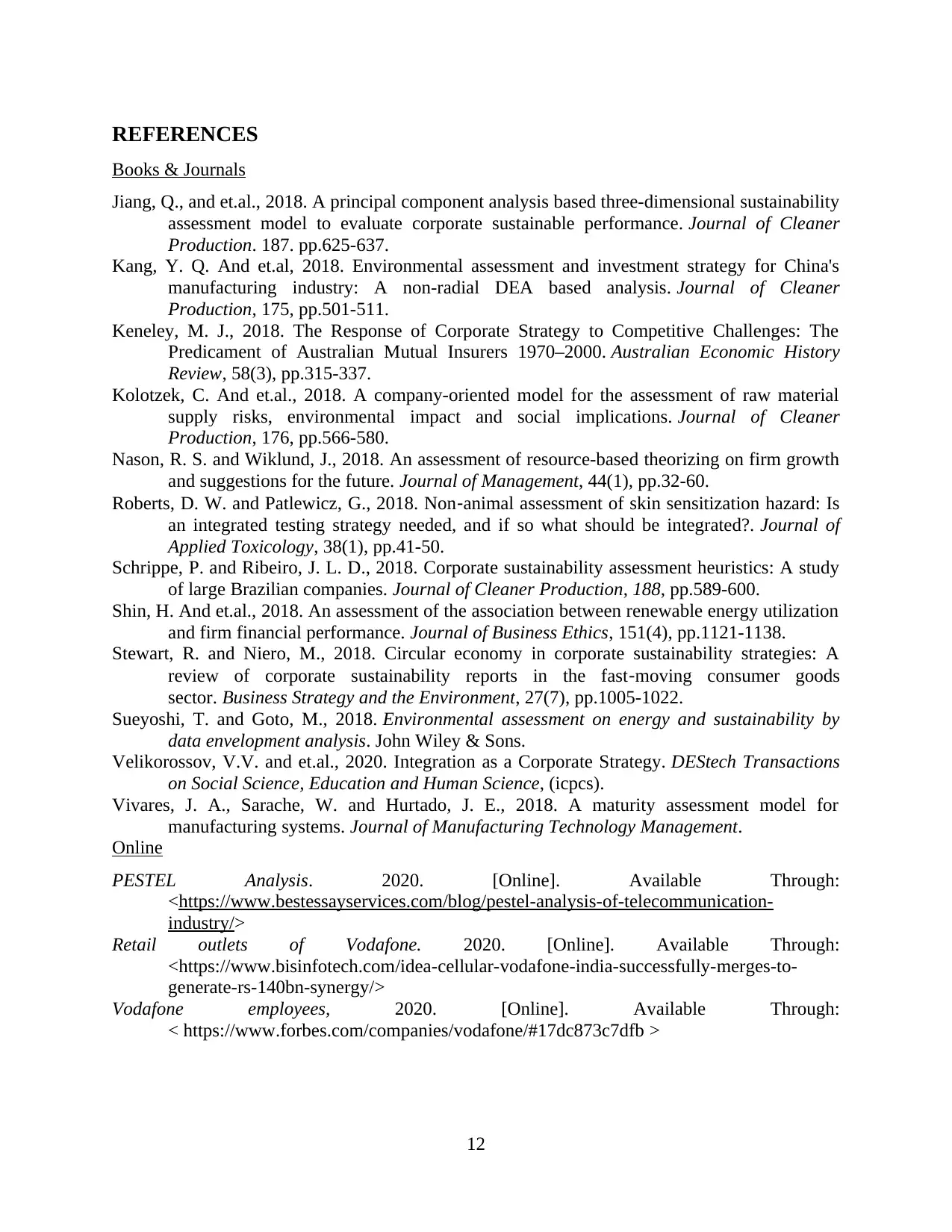
REFERENCES
Books & Journals
Jiang, Q., and et.al., 2018. A principal component analysis based three-dimensional sustainability
assessment model to evaluate corporate sustainable performance. Journal of Cleaner
Production. 187. pp.625-637.
Kang, Y. Q. And et.al, 2018. Environmental assessment and investment strategy for China's
manufacturing industry: A non-radial DEA based analysis. Journal of Cleaner
Production, 175, pp.501-511.
Keneley, M. J., 2018. The Response of Corporate Strategy to Competitive Challenges: The
Predicament of Australian Mutual Insurers 1970–2000. Australian Economic History
Review, 58(3), pp.315-337.
Kolotzek, C. And et.al., 2018. A company-oriented model for the assessment of raw material
supply risks, environmental impact and social implications. Journal of Cleaner
Production, 176, pp.566-580.
Nason, R. S. and Wiklund, J., 2018. An assessment of resource-based theorizing on firm growth
and suggestions for the future. Journal of Management, 44(1), pp.32-60.
Roberts, D. W. and Patlewicz, G., 2018. Non‐animal assessment of skin sensitization hazard: Is
an integrated testing strategy needed, and if so what should be integrated?. Journal of
Applied Toxicology, 38(1), pp.41-50.
Schrippe, P. and Ribeiro, J. L. D., 2018. Corporate sustainability assessment heuristics: A study
of large Brazilian companies. Journal of Cleaner Production, 188, pp.589-600.
Shin, H. And et.al., 2018. An assessment of the association between renewable energy utilization
and firm financial performance. Journal of Business Ethics, 151(4), pp.1121-1138.
Stewart, R. and Niero, M., 2018. Circular economy in corporate sustainability strategies: A
review of corporate sustainability reports in the fast‐moving consumer goods
sector. Business Strategy and the Environment, 27(7), pp.1005-1022.
Sueyoshi, T. and Goto, M., 2018. Environmental assessment on energy and sustainability by
data envelopment analysis. John Wiley & Sons.
Velikorossov, V.V. and et.al., 2020. Integration as a Corporate Strategy. DEStech Transactions
on Social Science, Education and Human Science, (icpcs).
Vivares, J. A., Sarache, W. and Hurtado, J. E., 2018. A maturity assessment model for
manufacturing systems. Journal of Manufacturing Technology Management.
Online
PESTEL Analysis. 2020. [Online]. Available Through:
<https://www.bestessayservices.com/blog/pestel-analysis-of-telecommunication-
industry/>
Retail outlets of Vodafone. 2020. [Online]. Available Through:
<https://www.bisinfotech.com/idea-cellular-vodafone-india-successfully-merges-to-
generate-rs-140bn-synergy/>
Vodafone employees, 2020. [Online]. Available Through:
< https://www.forbes.com/companies/vodafone/#17dc873c7dfb >
12
Books & Journals
Jiang, Q., and et.al., 2018. A principal component analysis based three-dimensional sustainability
assessment model to evaluate corporate sustainable performance. Journal of Cleaner
Production. 187. pp.625-637.
Kang, Y. Q. And et.al, 2018. Environmental assessment and investment strategy for China's
manufacturing industry: A non-radial DEA based analysis. Journal of Cleaner
Production, 175, pp.501-511.
Keneley, M. J., 2018. The Response of Corporate Strategy to Competitive Challenges: The
Predicament of Australian Mutual Insurers 1970–2000. Australian Economic History
Review, 58(3), pp.315-337.
Kolotzek, C. And et.al., 2018. A company-oriented model for the assessment of raw material
supply risks, environmental impact and social implications. Journal of Cleaner
Production, 176, pp.566-580.
Nason, R. S. and Wiklund, J., 2018. An assessment of resource-based theorizing on firm growth
and suggestions for the future. Journal of Management, 44(1), pp.32-60.
Roberts, D. W. and Patlewicz, G., 2018. Non‐animal assessment of skin sensitization hazard: Is
an integrated testing strategy needed, and if so what should be integrated?. Journal of
Applied Toxicology, 38(1), pp.41-50.
Schrippe, P. and Ribeiro, J. L. D., 2018. Corporate sustainability assessment heuristics: A study
of large Brazilian companies. Journal of Cleaner Production, 188, pp.589-600.
Shin, H. And et.al., 2018. An assessment of the association between renewable energy utilization
and firm financial performance. Journal of Business Ethics, 151(4), pp.1121-1138.
Stewart, R. and Niero, M., 2018. Circular economy in corporate sustainability strategies: A
review of corporate sustainability reports in the fast‐moving consumer goods
sector. Business Strategy and the Environment, 27(7), pp.1005-1022.
Sueyoshi, T. and Goto, M., 2018. Environmental assessment on energy and sustainability by
data envelopment analysis. John Wiley & Sons.
Velikorossov, V.V. and et.al., 2020. Integration as a Corporate Strategy. DEStech Transactions
on Social Science, Education and Human Science, (icpcs).
Vivares, J. A., Sarache, W. and Hurtado, J. E., 2018. A maturity assessment model for
manufacturing systems. Journal of Manufacturing Technology Management.
Online
PESTEL Analysis. 2020. [Online]. Available Through:
<https://www.bestessayservices.com/blog/pestel-analysis-of-telecommunication-
industry/>
Retail outlets of Vodafone. 2020. [Online]. Available Through:
<https://www.bisinfotech.com/idea-cellular-vodafone-india-successfully-merges-to-
generate-rs-140bn-synergy/>
Vodafone employees, 2020. [Online]. Available Through:
< https://www.forbes.com/companies/vodafone/#17dc873c7dfb >
12
1 out of 13
Related Documents
Your All-in-One AI-Powered Toolkit for Academic Success.
+13062052269
info@desklib.com
Available 24*7 on WhatsApp / Email
![[object Object]](/_next/static/media/star-bottom.7253800d.svg)
Unlock your academic potential
© 2024 | Zucol Services PVT LTD | All rights reserved.





